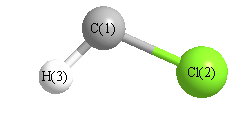Jump to
S2C1
Energy calculated at QCISD/3-21G
| | hartrees |
|---|
| Energy at 0K | -495.529055 |
| Energy at 298.15K | -495.528811 |
| HF Energy | -495.382831 |
| Nuclear repulsion energy | 34.800492 |
The energy at 298.15K was derived from the energy at 0K
and an integrated heat capacity that used the calculated vibrational frequencies.
Geometric Data calculated at QCISD/3-21G
Point Group is Cs
Cartesians (Å)
| Atom |
x (Å) |
y (Å) |
z (Å) |
|---|
| C1 |
0.047 |
1.350 |
0.000 |
| Cl2 |
0.047 |
-0.565 |
0.000 |
| H3 |
-1.071 |
1.513 |
0.000 |
Atom - Atom Distances (Å)
| |
C1 |
Cl2 |
H3 |
| C1 | | 1.9155 | 1.1298 |
Cl2 | 1.9155 | | 2.3602 | H3 | 1.1298 | 2.3602 | |
 More geometry information
More geometry information
Calculated Bond Angles
| atom1 |
atom2 |
atom3 |
angle |
|
atom1 |
atom2 |
atom3 |
angle |
| Cl2 |
C1 |
H3 |
98.300 |
|
Electronic energy levels
Charges, Dipole, Quadrupole and Polarizability
Jump to
S1C1
Energy calculated at QCISD/3-21G
| | hartrees |
|---|
| Energy at 0K | -495.534602 |
| Energy at 298.15K | -495.534375 |
| HF Energy | -495.416448 |
| Nuclear repulsion energy | 36.053322 |
The energy at 298.15K was derived from the energy at 0K
and an integrated heat capacity that used the calculated vibrational frequencies.
Geometric Data calculated at QCISD/3-21G
Point Group is Cs
Cartesians (Å)
| Atom |
x (Å) |
y (Å) |
z (Å) |
|---|
| C1 |
0.038 |
1.265 |
0.000 |
| Cl2 |
0.038 |
-0.555 |
0.000 |
| H3 |
-0.879 |
1.852 |
0.000 |
Atom - Atom Distances (Å)
| |
C1 |
Cl2 |
H3 |
| C1 | | 1.8206 | 1.0893 |
Cl2 | 1.8206 | | 2.5767 | H3 | 1.0893 | 2.5767 | |
 More geometry information
More geometry information
Calculated Bond Angles
| atom1 |
atom2 |
atom3 |
angle |
|
atom1 |
atom2 |
atom3 |
angle |
| Cl2 |
C1 |
H3 |
122.621 |
|
Electronic energy levels
Charges, Dipole, Quadrupole and Polarizability
